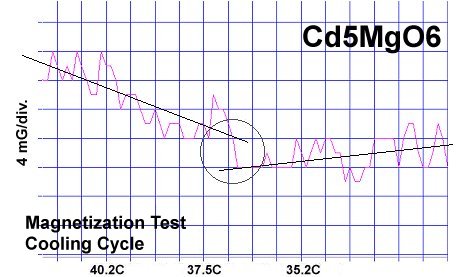
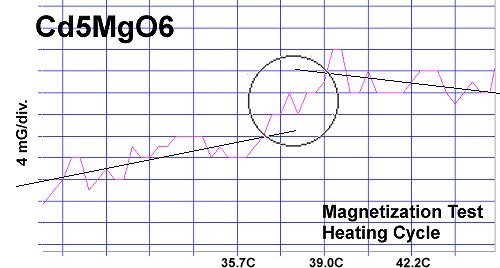


Superconductors.ORG herein reports synthesizing the first room-temperature superconductor that requires only 3 elements. The compound Cd5MgO6 has produced a critical transition temperature (Tc) near 37 Celsius (98F/310K) both magnetically and resistively. Both cooling and heating magnetization tests show Meissner transitions of 5-10 milligauss (at page top). Lines drawn through the noise to approximate the average of the data points also show a slope change. As with the prior 41 RT superconductors, the volume fraction (VF) of this discovery is low.
Since +2,+1 metals were recently found to be facilitators of high-temperature superconductivity, cadmium was selected to be the heavier of two metals that establish weight disparity on opposite sides of an oxygen atom. Theory predicted a weight ratio greater than 20:1 would be needed to achieve a Tc above room temperature. With magnesium as the second metal, the ratio is more than 23:1. Below are two direct resistance tests that also show a transition near 37C. (Up is higher resistance. Down is lower resistance.)[1]
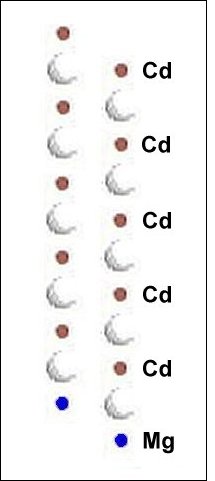
|
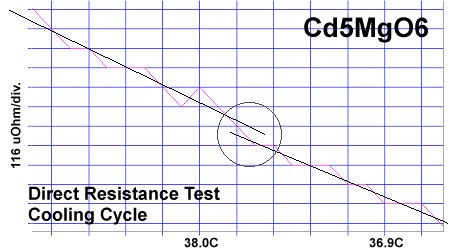
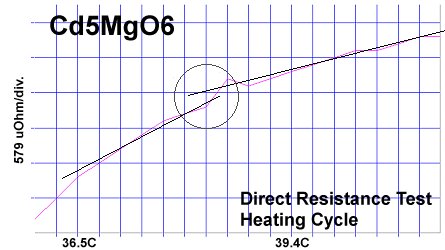
The value of Cd5MgO6 lies in its simple tetragonal structure, shown at left. Though 42 different room-temperature superconductors have now been discovered, all have a low volume fraction. If commercialization is to be realized, a method must be found to increase the VF to near 100%. A collinear structure would allow for molecular engineering or pulsed laser deposition as a mass-production method. Both are proven technologies. In the below graph Tc is plotted against planar weight ratio for known ternary superconductors. These ratios are roughly twice as high as the legacy copper-oxides that use Period 6 heavy metals like Ba, Hg, Tl, Pb, and Bi. However, in defense of this apparent inefficiency, the legacy curves typically roll over at higher Tc's. Cd5MgO6 (circled) appears to defy this tendency. |
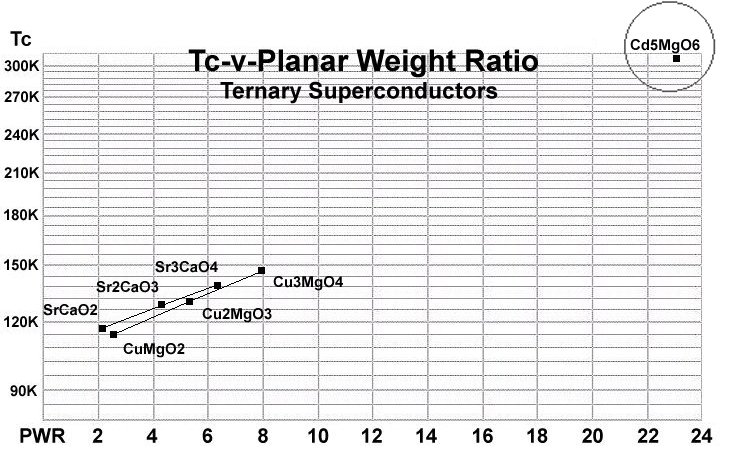
The below stoichiometric ratios were used in making this compound.
CdO 99.998% (Alfa Aesar) 15.10 grains
MgO 99.95% (Alfa Aesar) 0.95 grain
The chemical precursors were pelletized at 60,000 PSI and sintered for 10+ hours at 880C. The pellet was then annealed for 10+ hours at 500C in flowing O2. Temperature was determined using an Omega type "T" thermocouple and precision OP77 DC amplifier. The magnetometer employed twin Honeywell SS94A1F Hall-effect sensors with a tandem sensitivity of 50 mv/Gauss.
[1] The non-superconductive bulk had an unusually low resistance under 0.1 ohm. To observe a resistance change a constant-current source of 863 milliamperes was used to generate a voltage drop across the test pellet. Resistance was then calculated using the formula E/I=R. Anecdotally, the pellet was also extraordinarily hard for an oxide.
RESEARCH NOTE: These materials can be strongly hygroscopic. All tests should be performed immediately after annealing.
RE-PUBLICATION NOTICE: Elsevier Publishing, dba Elsevier Science, as well as Morris Communications, both print and broadcast divisions, are specifically prohibited from re-publishing any part of this news story.
E. Joe Eck
© 2016 Superconductors.ORG
All rights reserved.
 BACK to "News" page at Superconductors.ORG
BACK to "News" page at Superconductors.ORG